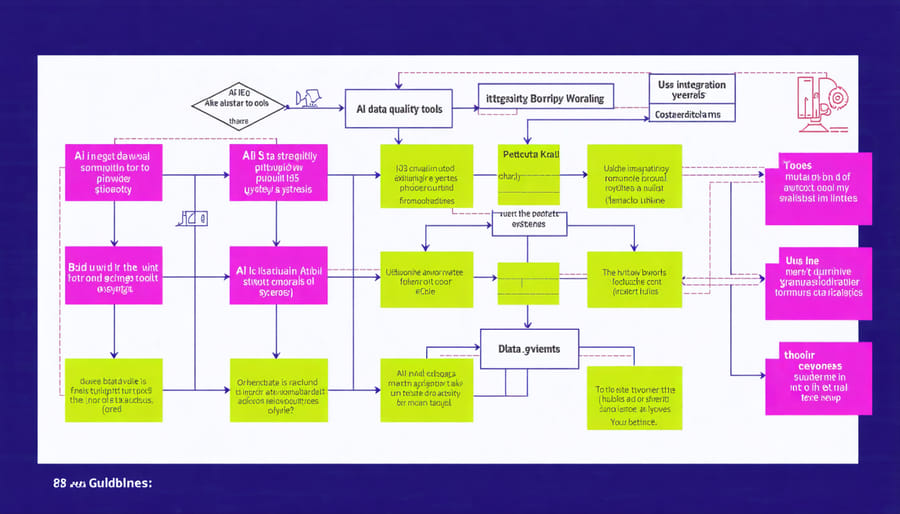Transform your data quality processes with AI-powered tools that automatically detect anomalies, standardize formats, and eliminate duplicate entries in real-time. Modern organizations generate massive datasets through time-series analysis and diverse data streams, making traditional manual quality checks obsolete. AI-based data quality tools now leverage machine learning algorithms to validate data accuracy, completeness, and consistency with unprecedented speed and precision.
These intelligent systems learn from historical patterns to identify potential errors, predict data quality issues before they impact operations, and suggest corrective actions—all while reducing the resource burden on data teams. By implementing AI-driven data quality solutions, organizations can achieve up to 90% reduction in manual data cleaning efforts while significantly improving the reliability of their analytics and decision-making processes.
From automated data profiling to intelligent schema matching and continuous monitoring, AI-based tools are revolutionizing how businesses ensure data integrity across their entire data pipeline. This transformation is essential for organizations seeking to maintain competitive advantage in an increasingly data-driven business landscape.
Why Traditional Data Quality Methods Fall Short for Time-Series Data
The Time-Series Data Quality Challenge
Time-series data presents unique quality challenges that traditional data validation methods often struggle to address. One of the most significant issues is temporal dependencies, where each data point is influenced by previous values. For example, in retail sales data, today’s sales figures are typically related to yesterday’s numbers and historical patterns.
Seasonality adds another layer of complexity, as it creates recurring patterns that must be distinguished from actual anomalies. Consider energy consumption data: a sudden drop during summer weekends might be normal, while the same decrease during peak business hours could signal a problem.
Missing values in time-series data are particularly troublesome because they can break the continuous flow of information. Unlike static datasets, you can’t simply remove incomplete records – doing so would disrupt the temporal sequence. Weather station readings, for instance, need continuous measurements to maintain accuracy in forecasting.
These challenges are compounded by the need for real-time processing in many applications. Modern IoT sensors and financial trading systems generate continuous streams of data that must be validated instantly, making traditional manual quality checks impractical and necessitating AI-powered solutions.

Limitations of Manual Quality Checks
Traditional manual data quality checks come with significant drawbacks that can impact business efficiency and accuracy. Human operators, no matter how skilled, can only process a limited amount of data in a given time, making it impossible to thoroughly check large datasets. This often leads to sampling-based approaches that might miss critical errors in unexamined portions of the data.
Manual checks are also prone to human error, especially when dealing with repetitive tasks or complex data patterns. Fatigue and attention lapses can result in inconsistent quality standards, and different team members might apply varying criteria when evaluating data quality.
Time consumption is another major limitation. Manual processes require substantial workforce hours, which could be better utilized for strategic tasks. Additionally, as data volumes grow exponentially, traditional methods become increasingly unsustainable and costly.
The inability to detect subtle patterns or correlations across massive datasets is particularly problematic. While humans excel at contextual understanding, they struggle to identify intricate relationships that might indicate data quality issues across millions of records. This limitation becomes more apparent when dealing with real-time data streams, where manual intervention simply cannot keep pace with the speed of data generation.
How AI-Powered Tools Transform Data Quality Management
Automated Anomaly Detection
Automated anomaly detection represents a breakthrough in data quality management, leveraging AI algorithms to identify outliers and unusual patterns that might slip past traditional monitoring methods. These intelligent systems continuously analyze data streams, making real-time data analysis more accurate and reliable.
Think of AI-based anomaly detection as a vigilant guardian that never sleeps. It learns what “normal” looks like for your data by analyzing historical patterns and establishing baseline behaviors. When something unusual occurs – whether it’s a sudden spike in website traffic or an unexpected drop in sensor readings – the system flags it immediately for investigation.
These tools employ various sophisticated techniques, including:
– Statistical modeling to establish normal data distributions
– Machine learning algorithms that adapt to evolving patterns
– Deep learning networks for complex pattern recognition
– Clustering analysis to group similar data points
What makes these systems particularly valuable is their ability to learn and improve over time. As they process more data, they become better at distinguishing between genuine anomalies and harmless variations. This reduces false positives and helps teams focus on truly significant issues.
For example, in e-commerce, these systems can detect fraudulent transactions by identifying unusual purchasing patterns. In manufacturing, they can spot equipment failures before they occur by recognizing subtle changes in performance metrics.

Intelligent Data Imputation
Intelligent data imputation represents a significant advancement in handling missing values within datasets, leveraging machine learning algorithms to predict and fill gaps with remarkable accuracy. Unlike traditional methods that rely on simple averages or deletion, AI-powered imputation analyzes patterns and relationships within the existing data to make informed predictions about missing values.
Modern imputation techniques employ various sophisticated approaches, including neural networks, random forests, and k-nearest neighbors algorithms. For example, when dealing with customer purchase history data, these systems can analyze seasonal patterns, customer behavior, and market trends to estimate missing transaction values with high precision.
One particularly effective method is the Multiple Imputation by Chained Equations (MICE) algorithm, which creates multiple complete versions of the dataset, analyzing the uncertainty in missing values across different scenarios. This approach provides more reliable results than single imputation methods, especially when dealing with complex datasets.
Recent advances in deep learning have introduced even more powerful imputation techniques, such as autoencoders and generative adversarial networks (GANs). These models can capture intricate relationships between variables and generate realistic synthetic data to fill gaps while maintaining the statistical properties of the original dataset.
The key advantage of AI-based imputation lies in its ability to adapt to different data types and contexts. Whether handling numerical, categorical, or time-series data, these systems can automatically select the most appropriate imputation strategy, significantly reducing manual intervention and improving overall data quality.
Pattern Recognition and Validation
AI-powered pattern recognition revolutionizes how we validate and verify data quality. These sophisticated systems can identify complex patterns, anomalies, and relationships within datasets that might escape human detection. By learning from historical data, AI algorithms establish baseline patterns and automatically flag deviations that could indicate quality issues.
For example, in customer relationship management systems, AI tools can detect inconsistent entry patterns across fields like phone numbers, email addresses, and postal codes. The system learns valid formatting patterns and alerts users when entries don’t match expected standards, preventing data quality issues before they cascade through the system.
Machine learning models excel at recognizing subtle correlations between data points. They can identify when certain combinations of values are statistically improbable, suggesting potential errors. For instance, in financial datasets, AI can spot unusual transaction patterns that might indicate data entry errors or system glitches.
These tools also adapt to evolving data patterns over time. As business rules change or new data formats emerge, AI systems automatically update their validation criteria without requiring manual reconfiguration. This dynamic approach ensures that data quality standards remain current and effective.
Pattern recognition capabilities extend to unstructured data as well. AI can analyze text fields for consistency, identify duplicate entries with slight variations, and ensure that free-form data adheres to business rules and quality standards. This comprehensive validation approach significantly reduces the risk of poor-quality data affecting business operations.
Implementing AI Data Quality Tools in Your Workflow
Tool Selection Criteria
When selecting AI-based data quality tools, several crucial factors need careful consideration to ensure you choose the solution that best fits your organization’s needs. First, evaluate the tool’s compatibility with your existing data infrastructure and formats. The tool should seamlessly integrate with your current systems and support the data types you commonly work with.
Consider the tool’s scalability and performance capabilities. As your data volume grows, the tool should efficiently handle increased workloads without significant performance degradation. Look for solutions that offer cloud-based options and can scale resources dynamically based on your needs.
Accuracy and precision of the AI algorithms are paramount. Review the tool’s track record in detecting and correcting data quality issues, and ask for case studies or proof of concepts. The best tools typically combine multiple AI techniques and allow for customization of quality rules based on your specific requirements.
Ease of use and implementation time are also critical factors. The tool should offer an intuitive interface that both technical and non-technical team members can navigate. Look for solutions with good documentation, training resources, and responsive technical support.
Cost considerations should extend beyond the initial purchase price. Factor in maintenance fees, training costs, and potential infrastructure upgrades. Some tools offer flexible pricing models based on data volume or user count, which might be more cost-effective for your situation.
Finally, evaluate the vendor’s reputation and commitment to innovation. Choose providers who regularly update their tools with new features and security patches, and have a clear roadmap for incorporating emerging AI technologies. This ensures your investment remains valuable as technology evolves.

Integration Best Practices
Successful implementation of AI-based data quality tools requires careful planning and execution. Start by conducting a thorough assessment of your current data infrastructure and quality requirements. This helps identify specific areas where AI tools can provide the most value.
When integrating AI tools into your existing workflow, follow these key steps:
1. Start small with a pilot project
2. Ensure proper data preparation and cleaning
3. Train your team on the new tools
4. Establish clear metrics for success
5. Monitor and evaluate results regularly
It’s crucial to understand the common pitfalls to avoid during implementation. These include insufficient data validation, lack of proper documentation, and inadequate user training. Organizations often rush into full-scale deployment without proper testing, leading to integration issues and reduced effectiveness.
Best practices for ongoing success include:
– Regular model retraining and updates
– Maintaining clear communication channels between technical and business teams
– Creating detailed documentation for processes and procedures
– Implementing robust security measures
– Establishing feedback loops for continuous improvement
Remember to maintain version control and keep track of changes in your data quality rules and models. This helps in troubleshooting issues and ensures consistency across different phases of implementation. Finally, develop a clear governance structure to manage your AI-based data quality initiatives effectively.
Measuring Impact and ROI
Measuring the impact and return on investment (ROI) of AI-based data quality tools requires a systematic approach combining both quantitative and qualitative metrics. Organizations typically start by establishing baseline measurements before implementation, focusing on key performance indicators like error rates, processing time, and resource allocation.
A common method is to track the reduction in manual data cleaning efforts, which often shows immediate cost savings. For example, companies frequently report 40-60% decreases in time spent on data cleaning tasks within the first few months of implementing AI quality tools. This translates directly into measurable cost savings and improved team productivity.
Quality metrics provide another crucial measurement angle. Track improvements in data accuracy rates, completeness scores, and consistency levels across datasets. Many organizations use a scorecard approach, monitoring these metrics monthly and comparing them against pre-AI implementation numbers.
Financial impact can be calculated by considering:
– Reduced labor costs for manual data cleaning
– Decreased error-related expenses
– Improved decision-making accuracy
– Enhanced operational efficiency
– Prevention of data-related incidents
Beyond numbers, consider qualitative benefits such as increased team satisfaction, better stakeholder confidence, and improved data-driven decision-making capabilities. Regular surveys and feedback sessions with end-users can provide valuable insights into the tool’s effectiveness.
Remember to document both direct and indirect benefits, as some improvements may not be immediately apparent in financial terms but contribute significantly to long-term organizational success.
AI-based data quality tools have revolutionized how organizations handle and process their data, offering unprecedented accuracy, efficiency, and scalability. These tools have proven invaluable in reducing manual effort, minimizing errors, and ensuring data consistency across various platforms and applications.
The key benefits we’ve explored include automated data validation, real-time monitoring, predictive error detection, and intelligent data cleansing. Organizations implementing these solutions have reported significant improvements in their data quality metrics, with some achieving up to 90% reduction in data-related errors and substantial cost savings in data management operations.
Looking ahead, the future of AI-based data quality tools appears increasingly promising. We can expect to see more sophisticated algorithms that can handle complex data relationships and patterns, enhanced natural language processing capabilities for unstructured data, and better integration with existing data management systems. The rise of federated learning and edge computing will likely influence how these tools evolve, enabling more efficient and privacy-conscious data quality management.
As data continues to grow in volume and complexity, AI-based data quality tools will become essential rather than optional. Organizations that embrace these technologies early will gain a competitive advantage through better decision-making, improved operational efficiency, and enhanced customer experiences. The ongoing development of more user-friendly interfaces and self-service capabilities will make these tools increasingly accessible to organizations of all sizes.
To stay ahead in this rapidly evolving landscape, organizations should maintain a proactive approach to adopting and updating their AI-based data quality solutions while ensuring their teams are properly trained to leverage these powerful tools effectively.

